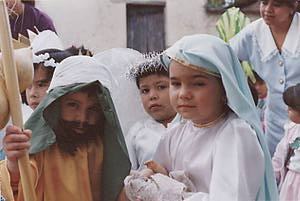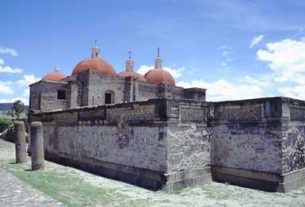At Home in Talpa de Allende, Jalisco

Did you ever go Christmas caroling, wrapped up against the cold, on a snowy night? Bring back memories of red, runny noses and your warm breath making clouds in front of your face? There usually was a cup of hot chocolate waiting for you somewhere along the way.
Mexican children have their nine days of posadas before Christmas. Two are chosen to dress up like Joseph and Mary and lead the other neighborhood children from house to house singing a request for a place to rest. There are singers inside the houses they pass who are programmed to sing a refusal of lodging. Finally, they arrive at a house where they are received and refreshments are served. Usually, there are several piñatas filled with wrapped candies and small toys. The kids, one by one, are blind-folded, given a strong stick and allowed their turn at whacking the piñata until it breaks and the toys and candy spill out.
In my neighborhood in Talpa de Allende, we actually had a Miracle Birth at our posada last year. The pregnant donkey carrying Virgin Mary up the hill was suddenly overcome with labor pains, and we had a baby donkey on our hands at the fiesta. That was perhaps a better education for the children than the piñatas. The miracle was that Mama Donkey didn’t throw the little Virgin Mary off her back.
Have you ever wondered what in the world the Christmas carol about all those leaping lords, French hens, geese a-laying and swans a-swimming was all about?
I am passing on to you a Christmas card I received a few years ago. I don’t think this is plagiarism, just sharing with you.
From 1558 to 1829, Roman Catholics in Europe were not allowed to practice their faith openly. Someone wrote the carol as a catechism song for the children. The words have a coded meaning, which helped the children to learn and remember the religious doctrine.
- The partridge in the pear tree was Jesus Christ.
- Two turtle doves were the Old and New Testaments.
- Three French hens represented faith, hope and love.
- Four calling birds were the four gospels: Matthew, Mark, Luke and John.
- Five golden rings were reminders of the first five books of the Old Testament: Genesis, Exodus, Leviticus, Numbers and Deuteronomy.
- Six geese a-laying stood for the six days of creation.
- Seven swans a-swimming represented the seven gifts from the Holy Spirit: Prophecy, Serving, Teaching, Exhortation, Contribution, Leadership and Mercy.
- Eight maids a-milking were the eight beatitudes.
- Nine ladies dancing were the nine fruits of the Holy Spirit: Love, Joy, Peace, Patience, Kindness, Goodness, Faithfulness, Gentleness and Self Control.
- Ten lords a-leaping were the Ten Commandments.
- Eleven pipers piping stood for the eleven faithful disciples.
- Twelve drummers drumming represented the twelve points of belief of the Apostles’ Creed.
May this be a joyful time for all of you wherever you might be.
From the Series “At Home in Talpa de Allende, Jalisco”
By Jenny McGill © Jenny McGill 2007 –

